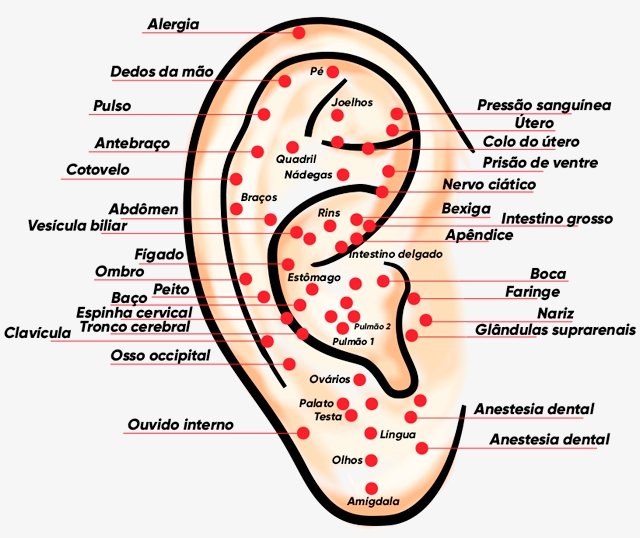Auriculotherapy
What is it?
Auriculotherapy is a therapeutic technique similar to acupuncture. In it, we use small, very thin needles, mustard seeds or magnetic spheres at specific points on the outside of the ears, or auricle, to establish the body’s energetic balance and help treat health problems such as anxiety, migraines or binge eating, for example.
This type of therapy has its origins in traditional Chinese and French medicine, and its basis is the idea that the human body can be represented in the ear, in the shape of a fetus, and, therefore, each point refers to a specific organ. Thus, by stimulating this point, it is possible to treat problems or alleviate symptoms in that same organ.

Indications
Auriculotherapy is indicated to assist in the treatment of various conditions, including muscle pain, sciatica, anxiety, depression, insomnia, migraine, binge eating, weight loss, hormonal disorders, PMS, allergies, asthma, bronchitis, flu, cough, smoking, water retention. liquids, urinary tract infection, respiratory, cardiac, digestive problems and temporomandibular disorders. Furthermore, it is used to treat high blood pressure, dizziness and palpitations.
Main points of auriculotherapy

Although French and Chinese auriculotherapy use the same technique, their ear maps are different, each country has created its own. The points on the ear correspond to specific organs in the body, allowing the treatment of various health conditions. It is crucial that auriculotherapy is carried out by a professional specialized in acupuncture, after analyzing the symptoms and defining the material to be used to stimulate specific points.
Benefits
In summary, auriculotherapy improves the symptoms treated, especially pain, and alleviates emotional symptoms associated with several illnesses, including depression and anxiety. Its advantages include easy application, wide indication, painlessness and rare side effects. ANAES, a French body equivalent to the Ministry of Health, recommended French auriculotherapy treatment for chronic and acute pain, anxiety, depression, digestive disorders, addictions, allergies and motor and urogenital recovery.
Contraindications
There are no absolute contraindications for auriculotherapy. It is crucial to disinfect the site before inserting the needles, especially for ASP (semi-permanent needles), with 70% alcohol. Patients with risk conditions, such as AIDS, diabetes, immunocompromised, use of anticoagulants or active infection, should be treated with care. During pregnancy, points such as the uterus, ovary, pituitary gland and genital organs may be contraindicated, although there is controversy about the possible harm to pregnant women.
How is it done?
Before starting treatment with auriculotherapy, it is crucial to consult an acupuncturist or a therapist specialized in acupuncture to identify the main symptoms and affected organs. Then, the professional selects the appropriate points and applies the technique, using filiform, intradermal needles, magnetic spheres or mustard seeds. Stimulating these specific points on the ear can relieve pain and treat physical or psychological problems, such as anxiety, migraines, obesity or contractures. Furthermore, auriculotherapy can help in the diagnosis and prevention of some diseases by observing altered ear points.
Frequency
The number of sessions required to obtain the expected benefits varies according to each case. Mild cases may show improvement from the first application, while others may need more stimulation. Generally, up to 10 sessions are recommended, depending on the method chosen. The professional can also suggest periodic therapies every six months or a year, depending on each person’s needs.
Care
If the places (points) where the seeds are located become painful, such as when we sleep on our side and the ear is compressed on the pillow or if we press the points too much, the painful stimulus can last up to 2 to 3 hours and disappear. If it persists, we must immediately remove the tape with the seed. The same applies if the pain is very intense, even before 2 hours have passed.
If the ear or the stitch site shows redness, secretions or pain for more than 2 to 3 hours, we must remove the inflamed areas.
If the stitches fall out, we must not replace them. If they are loose, they must be removed.
If one of the points falls out and there is the perception or sensation that it has entered the ear canal, DO NOT USE Q-tips. We should ask someone else to check if they can see the tape or seed at the entrance to the ear and remove them with tweezers. If it is not visible, DO NOT INSERT Q-tips. Look for an otorhinolaryngologist, who can use appropriate equipment to observe whether the tape or seed is present and remove them. To remove ear acupuncture points, use facial hair removal tweezers, washed with soap and water and dried on absorbent paper, and pull the tape that will come out with the seed. If the seed remains in the skin, after removing the tape, also remove it with tweezers.
